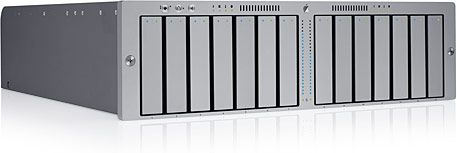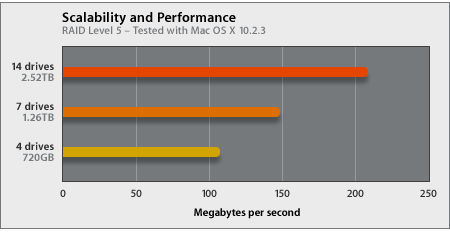
Fast throughput and data availability
are paramount for dedicated storage systems. That’s why Xserve RAID combines
leading-edge Fibre Channel, RAID and ATA technologies in an innovative architecture
designed for superior performance and reliability. Redundant, hot-swap components
and a passive midplane protect your digital assets from single points of
failure, while independent controllers and drive channels provide high-speed
throughput for delivering data quickly to the host system. Slower traffic, keep right
Slower traffic, keep rightXserve RAID features an advanced architecture that sustains storage performance at maximum levels across the entire array. The location or quantity of data on the array doesn’t appreciably affect throughput, ensuring consistent, fast data delivery. And the more drives you add, the better the performance. Slight drive train adjustment  Instead of relying on expensive SCSI or Fibre Channel hard drives, Apple
developed a high-throughput ATA-to-Fibre Channel storage architecture that
delivers superior performance and reliability at a much lower cost. Xserve
RAID achieves its massive 2.5TB capacity with 14 hot-swappable 180GB Apple
Drive Modules. The high-capacity 7200-rpm ATA/100 drive modules provide affordable
expansion and configuration flexibility as storage needs grow.
Instead of relying on expensive SCSI or Fibre Channel hard drives, Apple
developed a high-throughput ATA-to-Fibre Channel storage architecture that
delivers superior performance and reliability at a much lower cost. Xserve
RAID achieves its massive 2.5TB capacity with 14 hot-swappable 180GB Apple
Drive Modules. The high-capacity 7200-rpm ATA/100 drive modules provide affordable
expansion and configuration flexibility as storage needs grow.With 14 independent ATA/100 drive channels and dual RAID controllers, the Xserve RAID architecture eliminates traditional bottlenecks, maximizing throughput and ensuring fast access to stored data. Support for simultaneous storage processing also allows the performance to scale as capacity increases. Because each hard drive is isolated on its own bus, a drive failure doesn’t degrade the accessibility or performance of the surviving drives. Finely-tuned, independent motors The advanced Xserve RAID architecture delivers fast access to storage without compromising data integrity. Dual independent RAID controllers provide protected storage with unprecedented performance. In fact, Xserve RAID boasts a throughput of up to 400MB/s, fast enough to support real-time high-definition (HD) video editing without dropping a frame:
|
 Apple Drive Modules
Apple Drive ModulesEach Apple Drive Module is equipped with 8MB of cache memory for boosting throughput in performance-sensitive applications such as video editing. On-drive cache accelerates read and write speeds, but offers less protection in the event of a drive failure. For this reason, drive cache is turned off by default in protected RAID configurations, while video-optimized RAID sets and RAID 0 configurations activate drive cache by default. The drive controller can access data stored in the drive cache much more quickly than it can read from or write to the actual hard drive platters. Activating drive cache enhances overall system read speeds by allowing the drive controllers to retrieve a block of data before it is required by the host system. The RAID controller provides instructions to each drive in an array, indicating what data block is required next and allowing the individual drive controllers to queue up the data for instant availability. Redlining it Similarly, the drive cache serves as a holding tank for data that is being written to the hard drive. When the RAID controller distributes write data to each drive, it can be stored in cache memory, allowing the drive controller to notify the RAID processor immediately that transmission was successful, also known as a “committed write.” This frees up the storage pipeline for other needs while the data is being written to the drive platters at maximum speed. Using drive cache is inherently risky: If a drive were to fail during a write operation, the cached data could be lost. The performance needs of video editing and other high-throughput applications outweigh this risk in most situations, but activation of drive cache is not recommended where data protection is a critical requirement. |
|||||||||||||||||||||||||||||||||||||
| . | . | . |
| - |
RAID
|
Februar |
|
Xserver RAID
|
2003
|